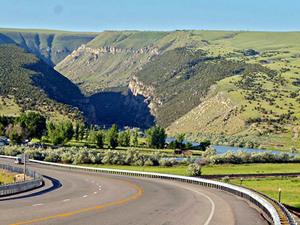Preserving Critical Habitats Will Help More Wildlife Survive
This morning, an article by Andrew Suggitt (How wildlife will keep cool. . . .) made me think again about refugia. Earlier, I concluded that unlike ice ages, global warming would leave no refugia in which pockets of wildlife would survive. I was picturing a pervasive atmospheric impact instead of a discontinuous physical impact by tongues of glacial ice. I was wrong. The best habitats for wildlife, the ones along streams, in deep shaded canyons, and those in areas of diverse topography will sustain more wildlife as climate changes. Preserving those habitats is an essential goal for wildlife conservation.

Rick Turley. Approaching Wind River Canyon.
Unfortunately, the best habitats for wildlife are the most desirable for humans. Worldwide, farming and home construction have destroyed the richest valley-floor habitats, and roads have filled the floors of canyons and narrow valleys. In the arid region where I live, livestock graze along rare desert streams and around lakes and marshes.
Preserving critical habitats is not a new idea. Conservation organizations have programs that identify and urge protection of important habitats. The National Audubon Society, for instance, has initiated the Climate Strongholds program that focuses on the needs of individual species. The program has strong citizen-scientist opportunities for participation. Read about it here.
Most wildlife species will be lost over the next few decades and centuries, but it will be possible to prevent some of the losses through preservation of critical habitats. As changing weather patterns force governments to respond to the climate emergency, nature conservation advocates must work hard to explain the critical role nature plays in human survival and to convince governments to protect the best wildlife habitats.
Half for Nature
Current climate projections suggest that global carrying capacity will drastically decline over the next few centuries. Human civilization as we know and imagine it now will not survive. Once the Earth’s energy budget stabilizes, people can begin to rebuild cities and networks and evolution can begin to rebuild natural plant and animal diversity. It no longer seems logical to advocate Half for Nature. There will be no half that could sustain the natural communities and diversity we have now. “Half” was never a practical goal anyway. In this blog post, I’ve advocated for the “Best” for nature. I hope that is a practical goal. There could be masses of people jammed into cool mountain canyons, but it could be trees and animals instead.

